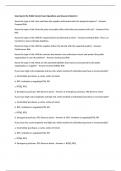Sourcing in the Public Sector Exam Questions and Answers Rated A+
Name the type of risk: How well does the supplier understand what the proposal requires? - Answers
Proposal Risk
Name the type of risk: Does the price accurately reflect what the procurement will cost? - Answers Price
Risk
Name the type of risk: Will the required items be delivered on time? - Answers Schedule Risk - This is an
incentive to meet schedule deadlines.
Name the type of risk: Will the supplier deliver the item(s) with the expected quality? - Answers
Performance Risk
Name the type of risk: Will the contract documents cover unforeseen issues and protect the public
organization in case of problems? - Answers Contractual Risk
Name the type of risk: What are the potential liabilities that may be encountered by the public
organization or supplier? - Answers Surety/liability Risk
If you have high cost/complexity and low risk, which method of solicitation/purchase is recommended?
a. Small dollar purchases, p-cards, notice of intent
b. RFP, invitation to negotiate(ITN), RFI
c. RFQQ, RFQ
d. Emergency purchase, ITB, Reverse action - Answers d. Emergency purchase, ITB, Reverse action
If you have high cost/complexity and high risk, which method of solicitation/purchase is recommended?
a. Small dollar purchases, p-cards, notice of intent
b. RFP, invitation to negotiate(ITN), RFI
c. RFQQ, RFQ
d. Emergency purchase, ITB, Reverse action - Answers b. RFP, invitation to negotiate(ITN), RFI
If you have low cost/complexity and high risk, which method of solicitation/purchase is recommended?
a. Small dollar purchases, p-cards, notice of intent
b. RFP, invitation to negotiate(ITN), RFI
c. RFQQ, RFQ
d. Emergency purchase, ITB, Reverse action - Answers c. RFQQ, RFQ
, If you have low cost/complexity and low risk, which method of solicitation/purchase is recommended?
a. Small dollar purchases, p-cards, notice of intent
b. RFP, invitation to negotiate(ITN), RFI
c. RFQQ, RFQ
d. Emergency purchase, ITB, Reverse action - Answers a. Small dollar purchases, p-cards, notice of intent
Which statement does not describe public procurement?
a. The funds expended are public and may be used only as prescribed by law under careful budgetary,
oversight, and auditing procedures.
b. Goods and services acquired for the use of government organizations and are usually intended for
resale or manufacturing purposes.
c. The procurement process is managed by public employees who are not motivated by profit-centered
objectives.
d. The size and scope of public procurement allows government to dominate the market unlike most
private organizations which place public procurement officials in a position of considerable power and
leverage. - Answers b. Goods and services acquired for the use of government organizations and are
usually intended for resale or manufacturing purposes.
List the 9 stages in the procurement process. - Answers 1. Information gathering/Analysis/Supplier &
Product development
2. Identify the Needs & Requirements definition
3. Specification & Standards
4. Review & Authorization
5. Source Document Preparation & competitive sourcing
6. Review, Evaluation, & Recommendation
7. Approval, Award, & Contract Formation
8. Acceptance, Certification, Payment, & Reporting
9. Post Award - Ongoing Supply Management & Planning Activities
Which one is not a method of solicitation?
a. Notice for Information (NFI)




